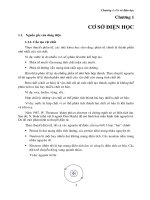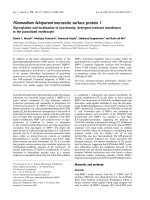Winged ants males Kiến cánh con đực
Bạn đang xem bản rút gọn của tài liệu. Xem và tải ngay bản đầy đủ của tài liệu tại đây (24.8 MB, 303 trang )
Winged Ants
The Male 00
Dichotomous key to genera of winged (S(Sants in the World
Behavioral Ecology of Mating flight
Stefano Cantone
0
Winged Ants
The Male 66
oo
Dichotomous key to genera of winged
ants in the World
Behavioral Ecology of Mating flight
Stefano Cantone
.r
~- J (
1
All rights reserved. This book or any portion thereof
may not be reproduced or used in any manner
whatsoever without the express written permission
of the
publisher except for the
use of brief
quotations in a book review.
Copyright© Stefano Cantone, 2017
www.wingedant.com
First Printing, 2017
ISBN979-12-200-2394-8
ISBN-A 10.979.12200/23948
Original text translation from Italian to English by Sarah Roberta Gonc;:alves
2
Winged Ants
The MalecScS
The purpose of the job is to earn free time
Aristotele
Stefano Cantone: Italian biologist, independent researcher with twenty years of experience
in ethological and entomological studies wandering in the World.
3
Index
1. Introduction p. 5
2. Dichotomous key to genera of winged
06
ants in the World p. 6
06 winged ants p. 6
2.2 The study of the 06 ants wings p. 7
2.1 Morphology of
2.2.1 Brief review of ants wings studies p. 7
2.2.2 Classification and analysis of the forewings and hindwings of oo ants p. 7
2.2.3 Morphology description forewings of
66
ants p. 20
2.2.4 Morphology description hindwings of ooants p. 32
2.2.5 Terminology and morphological aspects used in the dichotomous key p. 36
2.2.6 Reference Chapter 2 p. 38
2.3 Summary Typology of the oo ants wings p. 40
2.4 Dichotomous key to forewings of Typology I p. 41
2.5 Dichotomous key to forewings of Typology II p. 62
2.6 Dichotomous key to forewings of Typology Ill p. 80
2.7 Dichotomous key to forewings of Typology IV p. 97
3. Morphological description, data on mating flight and reference to genera of winged
ants p. 102
3.1 Subfamily Agroecomyrmecinae p. 102
3.2 Subfamily Amblyoponinae p. 102
3.3 Subfamily Aneuretinae p. 108
3.4 Subfamily Apomyrminae p. 109
3.5 Subfamily Dolichoderinae p. 110
3.6 Subfamily Dolyrinae p. 125
3.7 Subfamily Ectatomminae p. 142
3.8 Subfamily Formicinae p. 146
3.9 Subfamily Heteroponerinae p. 175
3.10 Subfamily Leptanillinae p. 177
3.11 Subfamily Martialinae p. 180
66
4
3.12 Subfamily Myrmeciinae p. 180
3.13 Subfamily Myrmicinae p. 182
3.14 Subfamily Paraponerinae, p. 251
3.15 Subfamily Ponerinae p. 251
3.16 Subfamily Proceratiinae p. 275
3.17 Subfamily Pseudomyrmecinae p. 277
4. Behavior Ecology of mating flight in ants p. 280
4.1 Introduction p. 280
4.2 Mating flight and habitat change p. 280
4.3 Annual periodicity analisys of mating flight in ants at different latitudes p. 282
4.4 Summer annual periodicity of mating flight in ants in the World p. 285
4.5 Annual periodicity of mating flight in some ant genera p. 286
4.5.1 Mating flight of genera Formica and Lasius p. 286
4.5.2 Mating flight of genera Dolichoderus and Pogonoyrmex p. 287
4.5.3 Mating flight of genus Camponotus p. 288
4.5.4 Mating flight of genus Atta p. 289
4.5.5 Mating flight of genus Pheido/e p. 290
4.5.6 Mating flight of genera Crematogaster and Wasmannia p. 291
4.5.7 Mating flight of genera Cyphomyrmex and Trachymyrmex p. 292
4.6 Mating flight and diversity of ants in urban ecosystem at Sao Paulo city, Brazil p. 293
4.6.1 Introduction p. 293
4.6.2 Material and methods p. 293
4.6.3 Diversity of ants in Sao Paulo city, Brazil p. 297
4.6.4 Mating flight analysis p. 299
4.6.5 Conclusions p. 309
Reference Chapter 4 p. 310
Genera Index p.314
Tables Index p. 317
5
1. Introduction
Ants are eusocial insects that form colonies made up of individuals with different
morphologies and functions. The abundance and behavior of ants in all land habitats is
legendary, influencing the existence and evolution of innumerable animal and plant species,
as extensively described in Holldobler and Wilson's famous book "The Ants" (1990).
In an ant colony the individuals cooperate in parental care. Are found sterile and fertile
individuals and there is always an overlapping of at least two generations that contribute to
the various activities of the colony.
Individuals, who make an ant colony, are specialized morphologically and ethologically
sometimes extreme, constituting the castes. An ant colony is divided, in most of the species,
in two castes:
1. The caste of workers, sterile, always without wings, who carry out activities of defense,
nest construction, nursing care, and search for food;
2. The royal caste, consisting of fertile females ( ~ ~ ) and males
The
ooand ~ ~ of the majority
(oo).
of species of ants are provided with wings, two on front
and two rear, which have the function of facilitating the meeting with individuals of the
opposite sex of other colonies for coupling (mating flight), favoring, thus, the dispersion of
the populations in the environment.
The goal of my work was to produce a dichotomous key to the identification of
oo
winged ants and an analysis of the periodicity of the mating flight. I present a study on the
morphology of the male ants wings in 260 genera, which I will use as the main
morphological characteristic for the writing of the dichotomous key. In the last chapter, I
present a study on the periodicity of the mating flight with a comparative analysis, in
different latitudes and habitats.
oo
Why study the
of ants?
I briefly expose my motives:
a. To better understand the phylogeny and systematic of the Formicidae family, expanding
knowledge about
oothat have little or very little known.
b. To help explain the great success of the ants in almost all terrestrial environments, where
they occupy a leading ecological function, validating the biological function of
oo as
essential in determining gene flow among the populations of most species;
c. As an excellent method to record the species diversity of ants community;
d. To record the periodicity of the Mating flight and its strategies, representing a path to
better understand the success of some species and as a possible indicator to detect the
effects of climate change, since the flattening mating seems to be particularly affected by
the climate.
6
2. Dichotomous key to genera of winged
ooants in the World
ooants
2.1 Morphology of winged
ooof ants are known for
external morphology easy-to-see characteristics with a simple optical stereo microscope. In
the Formicidae family, I found morphological descriptions of oo in 260 from about 404
For an identification at the taxonomic level of genus, the
genera knowns, which in many cases are related to very few species and few described
characteristics. This study is based on 260 genera belonging to all the 17 subfamilies of the
Formicidae family (Hymenoptera) currently present in the World, and were used as a basis
for it: publications of morphological descriptions, some specimens photos published on
Antwiki and Antweb websites represent the Typus or Paratypus that have been deposited in
entomological collections of various Museums and my personal collection of
In order to write up a dichotomous key of
morphological
characteristics
that
ooants in the
are encountered
oo.
world, I have chosen some
in the
majority
of
published
descriptions. For each genus studied I provide bibliographic references so is possible to
confirm the taxonomic identification using other morphological features.
This dichotomous key of
ooants represents a courageous attempt
to provide a simple
and scientifically credible tool for a first identification, for this reason I always recommend
an utmost caution in the definitive diagnosis completing the identification with the study of
cited bibliographic references, which are easy to consult on various websites. I say this
because, unfortunately, the
oo descriptions
of ants are in many cases superficial and
describe only very few morphological features, which, in some cases, do not allow to
distinguish some genera from another. In the following chapters, I will highlight these
scientific shortcomings hoping to be a useful indication for future studies.
I present a description of the outer body morphology of the
giving more attention
to the terminology
ooants with some figures
and morphological
aspects used in the
dichotomous key, and for further details are cited some bibliographic references.
7
2.2 The study of
ooants wings
In this study, I deepen the morphology aspects of the forewings and hindwings of
oo
ants, which represent the main characteristic on which my dichotomous key is written.
2.2.1 Brief review of ants' wings studies
The scholar Nylander (1846) was the first one to describe the wings of the European
Formicidae family. Later, Mayr (1855), in the study of the morphology of the Formicidae
family of the Austrian Empire, provided a more detailed description of the ants' wings giving
the name to the nervation that forms the cells using as the model the forewings of the
genus Formica .
The first real comparative analysis of the ants forewings was written by Prof. Carlo Emery
(1877 and 1913), the most illustrious taxonomist of the Formicidae family.
Subsequently, other comparative studies of the ants forewings were published: by Brown
and Nutting (1949) with a phylogenetic interpretation; by Ogata (1991) who classified the
forewings of the Formicidae family into four types, according to the structure of the
venation; and, recently, Perfilieva (2010) classifying the forewings into five types, relying,
like Ogata, on the structure of some cells that are formed from the encounter of the veins.
The only comparative study on the hindwings of the Formicidae family was made by
Kusnezov (1962).
ooants
In this study, I presented a classification of the forewings of the ooants divided into four
2.2.2 Classification and analysis of the forewings and hindwings of
Typologies and I classify the hindwings into three Typologies (see Table 12-13). In both
cases, the diversity of Typology is represented by a gradual reduction in wing venation as
studied by the aforementioned researchers.
This study is based on the
ooof 260 genera of ants belonging to
all 17 subfamilies
currently present in the World.
In reference to the forewings, I based my work in particular on the presence/absence of
subMarginal cells and Discoidal cells in Typologies I, II and Ill and a drastic reduction of veins
in Typology IV (see paragraph 2.2.3). Regarding the hindwings, I based my work on the
presence/absence of M2 vein in Typology I and II and on a strong reduction of veins in
Typology Ill (see paragraph 2.2.4). Below I describe the characteristics of the wings in the
different Typologies:
8
Forewings of Typology I (figs 1-4)
The morphology represented by this Typology is called by some authors as "complete". In
fact, it represents a more complex structure of ants' wings venations, where the two
subMarginal cells, the Discoidal cell and the Marginal cell are always present, which can be
opened or closed. In some cases, the subMarginal cell 2 is incomplete due to the reduction
of the Rs 2 + 3 vein (see fig. 4).
In the 260 genera I studied, Typology I in
ooants forewings is encountered in 73 genera
belonging to 12 subfamilies (see Table 14-15 and Graphic 1).
Proceratiinae 1
Pseudomyrmecinae 3 Amblyoponinae 3
Aneuretinae 1
I
Ectatomminae 4
Heteroponerinae 2
Graphic 1 - Distribution by subfamily and its number of genera with Typology I forewings in
ooants.
9
Forewings of Typology II (figs 5-7}
In this Typology, the forewings differ from the previous one Typology due to the absence
of the SubMarginal 2 cell. In the 260 genera studied, it is known in
66
of 116 genera
belonging to 11 subfamilies (see Table 17-18 and Graphic 2}. The structure of the venation
differs in genera, and in rare cases in species belonging to the same genus, for the position
of the vein M4 and for this reason, as described by Prof. Carlo Emery, they are respectively
referred as "solenopsis type" or "formica type".
Proceratiinae 1
Ponerinae 1
Pseudomyrmecinae 1
1groecomyrmecinae
1
Amblyoponinae 6
----.:;.:;:::-----
Apomyrminae 1
Myrmicinae 58
Graphic 2 - Distribution by subfamily and its number of genera with forewings of Typology II
in
66
ants.
10
Forewings of Typology Ill (figs 8-11)
The wings of this Typology are characterized by the absence of subMarginal
Discoidal cells. In the 260 genera studied there are
oo of
2 and
97 genera belonging to 7
subfamilies (see Table 19-20 and Graphic 3). Also in this Typology as in the Typology II, it can
be distinguish "solenopsis type" and "formica type" wings according to the position of the
M4 vein.
Proceratiinae 2
Dolichoderinae 5
Martialinae 1
Graphic 3 - Distribution by subfamily and number of genera with forewings of Typology Ill in
ooants.
11
Forewings of Typology IV (fig. 12 and Table 12)
In this latter Typology, there is a drastic decrease of the venation with the absence of
subMarginal and Discoidal cells, the Marginal cell is open or absent. In this Typology are also
included those genera that have very few veins. In the 260 genera studied there are
06
of
22 genera belonging to 6 subfamilies (see Table 21-22 and Graphic 4).
Amblyoponinae 1
Dorylinae 1
Graphic 4 - Distribution by subfamily and number of genera with forewings of Typology IV in
06
ants.
12
Hindwings of Typology I (figs 13-14)
In this Typology, are represented wings that have a more complete venation of the
Formicidae family. Basal and subBasal cells are always present. They differ in genera for the
presence/absence of the Jugal lobe. They are present in the genera of subfamilies
Amblyoponinae, Dorylinae, Ectatomminae, Heteroponerinae, Mirmeciinae, Ponerinae and
Paraponerinae. The Jugal lobe is present in some genera of subfamilies Ponerinae,
Ectatomminae, Mirmeciinae and Paraponerinae.
Hindwings of Typology II (fig. 15)
In this Typology the wings differ from the Typology I due to the absence of the Media 2
vein and the never present Jugal lobe. They are present in the genera of subfamilies
Amblyoponinae,
Aneuretinae,
Agroecomyrmecinae,
Dolichoderinae,
Dorylinae,
Ectatomminae, Heteroponerinae, Formicinae, Myrmicinae, Ponerinae, Proceratiinae and
Pseudomyrmeci nae.
Hindwings of Typology Ill (fig. 16 and Table 13)
In this latter Typology there is such a drastic reduction of veins that in some genera there
are no Anal vein and the subBasal cell and, in the most extreme cases not even one cell.
They
are
present
in
the
genera
of
subfamilies
Amblyoponinae,
Apomirminae,
Dolichoderinae, Dorylinae, Leptanillinae, Martialinae, Myrmicinae and Proceratiinae.
Changes in the Typology of the forewings can be found in species belonging to the same
genera and in some cases in individuals belonging to the same species.
In some cases there may be slight changes due to malformations in the development of
the veins, which are clearly identifiable and which I do not consider in this study.
Below I list in tables and charts, among the 260 genera studied, the genera in which the
species have
ooforewings
with an ever-present Typology and those genera where are
recorded species with the presence of different Typologies.
13
I have recorded 61 genera with species that always have a forewing venation structure of
Typology I (Table 1).
Generaof wingedJ J ants with Forewingsalwaysof TypologyI
Acanthoponera
Hagensia
Nothomyrmecia
Aenictogiton
Harpegnathos
Odontomachus
Aneuretus
Heteroponera
Odontoponera
Anillidris
Hypoponera
Ophtalmopone
Anochetus
Labidus
Pachycondyla
Aptinoma
Leptogenys
Paltothyreus
Bothroponera
Liometopum
Paraponera
Brachyponera
Manica
Pheidole
Centromyrmex
Mayaponera
Phrynoponera
Cheliomyrmex
Megaponera
Plathytyrea
Chrysapace
Mesoponera
Plectroctena
Cylindromyrmex
Messor
Ponera
Cryptopone
Myopopone
Psalidomyrmex
Diacamma
Myrcidris
Pseudomyrmex
Dinoponera
Myrmecia
Pseudoneoponera
Dolichoderus
Myopias
Pseudoponera
Eciton
Mystrium
Rasopone
Ectatomma
Neivamyrmex
Rhytidoponera
Ectomomyrmex
Neoponera
Stigmatomma
Euponera
Nomamyrmex
Streblognathus
Goniomma
Table 1 - List of genera with species always presenting the forewings of Typology I.
14
I have registered 81 genera with species that always have a structure of forewings
venation of Typology II (Table 2).
Genera of winged
ooants with Forewingsalwaysof TypologyII
Adelomyrmex
Eburopone
Myrmecorhynchus
Procryptocerus
Adetomyrma
Epe/ysidris
Myrmicaria
Proformica
Aenictus
Eusphinctus
Myrmisaraka
Ravavy
Amblyopone
Eutetramorium
Myrmoteras
Rhytidoponera
Anonycomyrma
Formica
Neocerapachys
Rogeria
Apomyrma
Froggattel/a
Ochetellus
Rostromyrmex
Atopomyrmex
Gesomyrmex
Ochetomyrmex
Simopone
Axinidris
Harpagoxenus
Onychomyrmex
Sphinctomyrmex
Azteca
Huberia
Ooceraea
Strongy/ognathus
Blepharidatta
lberoformica
Orectognathus
Syllophopsis
Bondroitia
lndomyrma
Oxyepoecus
Tanipone
Calyptomyrmex
lridomyrmex
Oxyopomyrmex
Tatuidris
Carebara
Liomyrmex
Papyrius
Thaumatomyrmex
Cephalotes
Lioponera
Parasyscia
Tranope/ta
Cerapachys
Lividopone
Paratopu/a
Turneria
Cyatta
Lophomyrmex
Patagonomyrmex
Veromessor
Dacetinops
Lordomyrma
Philidris
Vitsika
Dilobocondyla
Ma/agidris
Poliergus
Xymmer
Do/eromyrma
Meranop/us
Prionopelta
Yunodorylus
Do/opomyrmex
Mesostruma
Dory/us
Metapone
Zasphinctus
Table 2 - List of genera with species always presenting forewings of Typology II.
15
I have registered 67 genera with species that always have a structure of forewings
venation of Typology Ill (Table 3).
Genera of winged
<3<3
ants with
Forewings always of Typology Ill
Acromyrmex
Melophorus
Podomyrma
Allomerus
Mycetophylax
Polyrhachys
Anoplolepis
Mycetagroicus
Prenolepis
Aphomomyrmex
Mycetarotes
Pristomyrmex
Apterostigma
Mycetophylax
Proatta
Arnoldius
Mycetosoritis
Proceratium
Atta
Myrmecina
Prolasius
Brachymyrmex
Myrmelachista
Pseudoatta
Calomyrmex
Myrmycocrypta
Pseudolasius
Camponotus
Nesomyrmex
Rhopalomastix
Cataulacus
Notoncus
Romblonella
Cladomyrma
Notostigma
Rossomyrmex
Colobopsis
Novomessor
Sericomyrmex
Cyphomyrmex
Nylanderia
Stereomyrmex
Daceton
Octostruma
Stigmacros
Dinomyrmex
Ocymyrmex
Tapinolepis
Dyscothyrea
Oecophylla
Technomyrmex
Euprenolepis
Overbeckia
Trachymyrmex
Kalathomyrmex
Paramycetophylax
Tropidomyrmex
Lepisiota
Paraparatrechina
Wasmannia
Leptanilloides
Paratrechina
Zatania
Martialis
Petalomyrmex
Melissotarsus
Plagiolepis
Table 3 - List of genera with species always presenting Forewings of Typology Ill.
16
I have registered 9 genera with species that always have a structure of forewings
venation of Typology IV (Table 4).
Genera of Wingedi5if ants with Forewingsalwa~sof TypologyIV
Acanthognathus
Leptanilla
Noonilla
Phaulomyrma
Probolomyrmex
Scyphodon
Syscia
Xenomyrmex
Yavnella
Table 4 - List of genera with species always presenting Forewings of Typology IV.
I have registered 10 genera with species that have a structure of forewings venation
which varies from Typology I to Typology II (Table 5).
Genera of winged
cfd'ants with
Forewings of Typology I and II
Acanthostichus
Aphaenogaster
Gnamptogenys
Linepithema
Myrmica
Pogonomyrmex
Proceratium
Stegomyrmex
Tetraponera
Typhlomyrmex
Table 5 - List of genera with species presenting Forewings of Typology I and II.
17
I have registered 18 genera with species that have a structure of forewings venation
which varies from Typology II to Typology Ill (Table 6).
Genera of winged
,3(!,ants with
Forewings of Typology II and Ill
Acanthomyrmex
Acropyga
Bajacadridis
Basiceros
Cataglyphis
Lasiophanes
Lasius
Leptothorax
Mega/omyrmex
Mirmecocystus
Monomorium
Opistopsis
Royidris
Solenopsis
Tapinoma
Terataner
Tetramorium
Trichomyrmex
Table 6 - List of genera with species presenting Forewings of Typology II and Ill.
I have registered 7 genera with species that have a structure of forewings venation which
varies from Typology Ill to Typology IV (Table 7).
Genera of winged
def ants with
forewings of Typology Ill and IV
Cardiocondyla
Dorymyrmex
Eurhopa/otrix
Forelius
Mycocepurus
Recurvidris
Strumigenys
Table 7 - List of genera with species presenting forewings of Typology Ill and IV.
18
I have registered 1 genus with species that have a structure of the forewings venation
which varies from Typology I to Typology II and Ill (Table 8).
Genera of winged JJ ants with forewings of TypologyI, II and Ill
Stenamma
Table 8 -Stenamma is the only genus presenting forewings of Typology I, II and Ill.
I have registered 4 genera with species that have a structure of forewings venation which
varies from Typology II to Ill and IV (Table 9).
Genera of winged J c3ants with forewings of TypologyII, Ill and IV
Bothriomyrmex
Crematogaster
Fulakora
Temnothorax
Table 9 - List of genera with species presenting forewings of Typology II, Ill and IV.
I have registered 1 genus with species that have a structure of forewings venation which
varies from Typology I to II and IV (Table 10).
Genera of winged J J ants with forewings of TypologyI, II and IV
Leptomyrmex
Table 10- Leptomyrmex is the only genus presenting forewings of Typology I, II and IV.
I have registered 1 genus with species that have a structure of forewings venation which
varies from Typology II to IV (Table 11}.
Genera of winged
c3c3
ants with
Forewings of Typology II and IV
Vollenhovia
Table 11- Vollenhovia is the only genus presenting forewings of Typology II and IV.
19
In summary, I represent, with graphs 6 and 7, how the wings of the
ooants of the 260
genera studied in the Formicidae family are distributed in the different Typologies.
Forewingsfor Tipology
90
80
70
...
cu
RI
C
cu
QI)
0
60
50
40
C
30
20
10
0
Typology
• n° genera
61
II
Ill
IV
81
67
9
Gaphic 6 -Distribution of the genera of the
1-11
10
11-111 Ill-IV
18
7
ooants with different
Graphic 7 - Distribution in % of the genera of the
Typologies.
1-11-11111-111-IV1-11-IV II-IV
1
4
1
1
oo ants
forewings Typologies.
with different forewings
20
2.2.3 Morphology description of Forewings of
ooants
Typology I
Cells
Pterostigma
subdiscoidal
2
Veins and cross-veins
2radius-radial
sector
Radial
mediaCubitus 3
Media 3
Figure 1: Forewing cells and veins of genus Neivamyrmex
cf
ector 4-5
21
Typology I
Cells
Sub marginal 1
Marginal open
Sub marginal 2
Veins and Cross-veins
A
m-cu
Figure 2: Forewing cells and veins of genus Pheido/e J.
Veins: C: Costa; Sc: SubCosta; M: Media; Cu: Cubitus; A: Anal; Rs: Radial sector; R: Radius
Cross-veins: cu-a: cubitus+anal; m-cu: media+cubitus; rs-m: radial sector+media; r-rs: radius+radial
sector.
22
Typology I
Cells
Marginal
Costa
Subdiscoldal
1
Veins and Cross-veins
Figure 3: Forewing veins of Pachycondyla striata
o,Brazil.
Veins: C: Costa; Sc: SubCosta; M: Media; Cu: Cubitus; A: Anal; Rs: Radial sector; R: Radius
Crossveins: cu-a: cubitus+anal; m-cu: media+cubitus; rs-m:radial sector+media; r-rs:radius+radial
sector.
23
Typology I
Cells
Veins and Cross-veins
C
Cu2
m-cu
M2+M 3 M
4
Figure 4: Forewing veins of Gnamtogenys sp. 336 (S, Brazil.
Veins: C: Costa; Sc:Subcosta; M: Media; Cu: Cubitus; A: Anal; Rs: Radial sector; R: Radius
Crossveins: cu-a: cubitus+anal; m-cu: media+cubitus; rs-m: radial sector+media; r-rs: radius+radial
sector.









